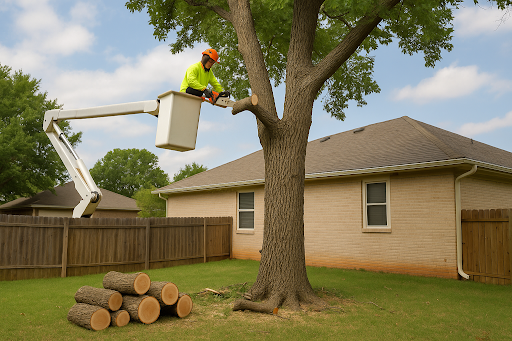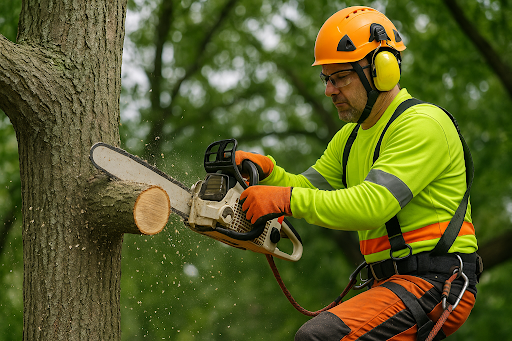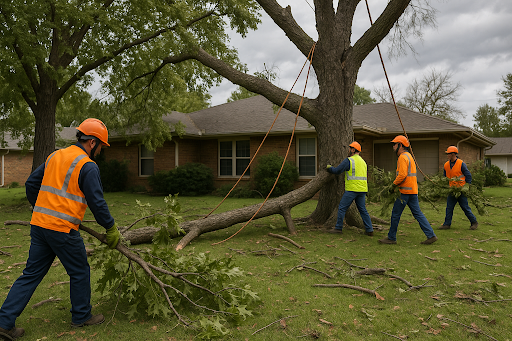
If you’re wondering how much it costs to cut down a tree, you’re not alone. While there’s no universal price tag, understanding the factors that affect tree removal costs can help you make an informed decision about your property’s safety and care. In this guide, we’ll break down what influences pricing and when it’s best to call a certified arborist for help.
Why There’s No One-Size-Fits-All Price
Every tree—and every property—is different. That’s why professional estimates vary. The cost of tree removal depends on several factors, including tree size, location, health, and any safety challenges involved. Understanding these elements can help you prepare for what to expect when scheduling your removal.
1. Tree Size, Shape, and Species
Larger, taller trees require more planning, equipment, and time than smaller ones. Species matters, too. Dense hardwoods often require specialized cutting techniques, while trees with wide canopies or complex branching can take additional effort to dismantle safely.
Learn more about safe and efficient removals by visiting our tree removal services page.
2. Tree Health and Stability
A tree’s health plays a significant role in how it’s removed. Healthy trees may require more cutting due to their weight and density, while dead, dying, or diseased trees may be unstable and need extra precautions. Signs like hollow trunks, fungal growth, or splitting limbs can all influence removal strategies.
If you suspect your tree may be declining, our plant health care programs can often help diagnose issues before removal becomes necessary.
3. Location and Accessibility
A tree’s position on your property heavily impacts removal complexity. For example:
- Is it close to your home, garage, or fencing?
- Is it near utility lines or neighboring structures?
- Is the terrain sloped, rocky, or difficult to navigate?
Tight spaces and limited access often require specialized equipment or dismantling techniques, both of which can affect the final price.

4. Storm Damage and Emergency Situations
After a severe Oklahoma storm, damaged or partially fallen trees can pose immediate hazards to your property and safety. Emergency removals often require fast response times, heavy equipment, and additional crews to stabilize dangerous conditions.
If you’ve experienced weather-related tree damage, our storm damage cleanup team is available to safely restore your property.
5. Additional Services That Affect Pricing
Tree removal isn’t always as simple as cutting a trunk. Additional services—like stump grinding, hauling debris, or preparing the site for replanting—can influence the final cost.
If you’re planning to replace your tree, our expert tree planting services can help you select and install the right species for your landscape.
6. Permits and Local Regulations
Some neighborhoods and HOAs have restrictions on tree removal, especially for protected species or larger trees. While permits aren’t always required, navigating local guidelines properly ensures a smooth, compliant removal process. Our arborists can advise you on requirements before beginning work.
7. Equipment, Crew Size, and Safety Protocols
Removing a small ornamental tree is far different from dismantling a 60-foot oak near your roofline. Larger or more hazardous jobs may require cranes, bucket trucks, rigging, and additional safety measures. Each factor influences logistics and planning, which is why on-site assessments are critical.
8. Company Expertise and Certifications
Not all tree services are created equal. Working with ISA-certified arborists ensures you’re getting trained professionals who follow industry best practices and maintain proper licensing and insurance. At Arbor Image Tree Care, safety, efficiency, and care for your property come first—every time.
Why Cutting Corners Can Be Risky
DIY tree removal may sound cost-effective, but it’s one of the most dangerous tasks homeowners attempt. Without the right training, gear, and strategy, it’s easy to misjudge how a tree will fall, potentially causing injury or property damage. Hiring certified professionals gives you peace of mind that the job will be done right and safely.
How to Get a Clear, Accurate Estimate
Since no two trees—or properties—are exactly alike, the best way to understand tree removal pricing is with an on-site consultation. Here’s what you can expect when working with Arbor Image Tree Care:
- Comprehensive Evaluation
We’ll inspect the tree’s size, stability, and surrounding area to assess the safest removal method.
- Transparent Recommendations
If your tree can be saved, we’ll explain your options—including our plant health care services—to preserve it when possible.
- Detailed Estimates
You’ll receive a clear, customized breakdown with no hidden fees.
Helpful Resources for Homeowners
If you’re considering tree removal, these resources can help you make informed decisions:
- Tree Removal Services — Learn when and why removal is necessary.
- Plant Health Care — Discover how proactive care can prevent tree loss.
- Can I Ignore a Damaged Tree? — Understand when immediate action is needed.
- Signs of a Dying Tree — Spot problems early before they spread.
Friendly Advice From Arbor Image

Tree removal isn’t a one-size-fits-all service. From species and size to location and safety concerns, multiple factors affect pricing. While online estimates can give you a rough idea, nothing replaces a professional assessment.
If you’ve been asking yourself, “How much does it cost to cut down a tree?” the next step is simple—reach out to our team for a personalized consultation. We’ll evaluate your property, walk you through your options, and provide clear, trustworthy recommendations.
Contact Arbor Image Tree Care today to schedule your on-site assessment and get expert advice tailored to your needs.
